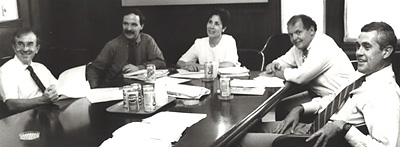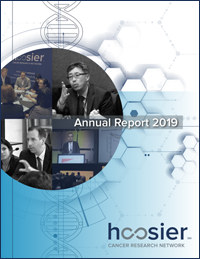As the books closed on 2019, Hoosier Cancer Research Network approached a familiar juncture. The organization’s steady growth, both in numbers as well as in the range and quality of service we provide, have led us to full capacity in our present location. There is only so much creative reorganizing you can do in a limited space.
I am pleased to announce that this spring, HCRN will move to its new home at 7676 Interactive Way, on the northwest side of Indianapolis. This new location, visible from I-465 between the 71st and 86th Street exits, nearly doubles the square footage of our space in the 500 North Meridian building, and offers ample room to expand in certain key areas of immediate and future need, such as:
- Additional storage space and resources for the biorepository and correlative research team.
- Additional conference rooms to accommodate the active schedules of Clinical Trial Working Groups and study-specific teleconferences.
- Additional offices and cubicles for our growing staff.
In many ways, HCRN has come full circle, experiencing familiar challenges that come with growth. While it may feel like we’ve been here before, viewing our “story” in perspective shows each cycle has led the organization to a new stage in its development.
 Let’s look back on where we’ve been and how far we’ve come, and in the process pay tribute to some of our greatest champions.
Let’s look back on where we’ve been and how far we’ve come, and in the process pay tribute to some of our greatest champions.
Legend has it that the vision for Hoosier Oncology Group began in the mid-1980s with a “HOG” logo sketched on the back of a cocktail napkin. Dr. Patrick Loehrer, distinguished professor at the Indiana University School of Medicine and director of the IU Simon Comprehensive Cancer Center, and Dr. Lawrence Einhorn, distinguished professor at the IU School of Medicine whose research led to the cure for testicular cancer, envisioned a collaboration that would bring together academic researchers and community oncologists to offer novel clinical trials to patients within their own communities.
Very soon, a group of community oncologists across the Hoosier state — Drs. R. Prasad Mantravadi, Rafat Ansari, Kenneth Pennington, and William Fisher — joined their academic colleagues. Rounding out the early executive committee were the late Dr. Steve Williams, then director of the IU Simon Cancer Center, and Sandra Turner, who would steer the early growth of the HOG as its first executive director, until she herself faced a cancer diagnosis that ultimately claimed her life.
 From the mid-1980s to 2007, the HOG operated under the umbrella of the Walther Cancer Institute (now known as the Walther Cancer Foundation), with offices located in the spacious and historic home of Dr. Joseph E. Walther on North Meridian Street in Indianapolis. HOG investigators were prolific, initiating 130+ studies in more than 15 cancer types and supportive care with 40+ sites participating in the HOG network. Several studies during this era resulted in significant findings that established the HOG as a valued research collaborator among funders and key academic institutions alike. As the HOG’s reputation grew, so too did its footprint, with new sites continually dotting the map from coast to coast.
From the mid-1980s to 2007, the HOG operated under the umbrella of the Walther Cancer Institute (now known as the Walther Cancer Foundation), with offices located in the spacious and historic home of Dr. Joseph E. Walther on North Meridian Street in Indianapolis. HOG investigators were prolific, initiating 130+ studies in more than 15 cancer types and supportive care with 40+ sites participating in the HOG network. Several studies during this era resulted in significant findings that established the HOG as a valued research collaborator among funders and key academic institutions alike. As the HOG’s reputation grew, so too did its footprint, with new sites continually dotting the map from coast to coast.
The years 2007 through 2014 brought a series of transitions. Change was not always comfortable, but it was necessary to build the foundation for the growth that would follow. In 2007, the HOG became an independent 501(c)(3) nonprofit organization under the leadership of then executive director Jake Vinson. With that change, the HOG made its first big move, to the Indiana University Research Technology Center on West 10th Street, near the IU School of Medicine. The new facility allowed the HOG to establish its first dedicated biorepository room, with space for both ambient and frozen sample storage.
 The move to West 10th Street coincided with a transition to the HOG’s first electronic data capture (EDC) system. Gone were the days of paper-based case report forms. The speed and efficiency of data input grew tremendously during this time. With greater efficiency came greater demand for the HOG’s services, and the network continued its growth as Cyndi Burkhardt took the reins as executive director in 2012. Recognizing the organization’s maturity into a nationwide, full-service clinical research organization, the HOG’s leaders chose to rebrand as Hoosier Cancer Research Network (HCRN) in 2014. By that time, HCRN employed nearly 30 full-time staff members and had reached capacity. It was time for another move, and in December 2014 the doors opened at HCRN’s new offices at 500 North Meridian Street.
The move to West 10th Street coincided with a transition to the HOG’s first electronic data capture (EDC) system. Gone were the days of paper-based case report forms. The speed and efficiency of data input grew tremendously during this time. With greater efficiency came greater demand for the HOG’s services, and the network continued its growth as Cyndi Burkhardt took the reins as executive director in 2012. Recognizing the organization’s maturity into a nationwide, full-service clinical research organization, the HOG’s leaders chose to rebrand as Hoosier Cancer Research Network (HCRN) in 2014. By that time, HCRN employed nearly 30 full-time staff members and had reached capacity. It was time for another move, and in December 2014 the doors opened at HCRN’s new offices at 500 North Meridian Street.
In the years since the move to “500 North,” HCRN has added strategic staff positions in several departments, including finance and contracting, research development, research operations, safety and regulatory, data management, informatics, and correlative services. Under Burkhardt’s steady leadership, HCRN’s growth has accelerated at an unprecedented pace. Consider the following metrics from 2014 compared with 2019:
- Studies (current + active development):
- 2014: 15+
- 2019: 80+
- Sponsor-investigators (lead PIs):
- 2014: 10+
- 2019: 55+
- Number of Clinical Sites:
- 2014: 130+
- 2019: 450+
- Number of Study Funders:
- 2014: 10+
- 2019: 30+
 As 2019 drew to a close, HCRN had once again come full circle, reaching capacity at 500 North, and final negotiations were underway to secure a new office location.
As 2019 drew to a close, HCRN had once again come full circle, reaching capacity at 500 North, and final negotiations were underway to secure a new office location.
We anticipate opening our new offices in May. Knowing that change can be disruptive, we’ve worked hard to ensure this transition will be as seamless as possible. HCRN has put together a fact sheet about the move for our members, funders, and study teams. The fact sheet may be viewed here. HCRN staff are happy to answer your questions. Send a message through the HCRN contact form, send an email to contact@hoosiercancer.org, or call the HCRN offices at 317-921-2050 at any time.
Thank you to all our member sites, investigators, study teams, funders, and champions who have been a part of the HOG/HCRN story. We are grateful for your collaboration and support over the years.
– Christopher A. Fausel, PharmD, MHA, BCOP, chairman of the Board of Directors, Hoosier Cancer Research Network; clinical manager, Oncology Pharmacy, Indiana University School of Medicine
Read more in HCRN’s 2019 Annual Report.
About Hoosier Cancer Research Network:
Hoosier Cancer Research Network (formerly known as Hoosier Oncology Group) conducts innovative cancer research in collaboration with academic and community physicians and scientists across the United States. The organization provides comprehensive clinical trial management and support, from conception through publication. Created in 1984 as a program of the Walther Cancer Institute, Hoosier Cancer Research Network became an independent nonprofit clinical research organization in 2007. Since its founding, Hoosier Cancer Research Network has conducted more than 210 trials in a variety of cancer types and supportive care, resulting in more than 350 publications. More than 8,500 subjects have participated in Hoosier Cancer Research Network clinical trials.

